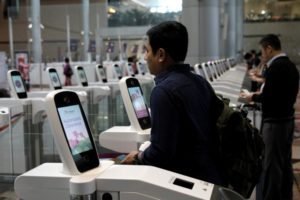Last updated on March 22nd, 2024 at 04:12 am
The novel coronavirus pandemic has forced a majority of countries around the world to enforce lockdowns. Although met with initial resistance, a large chunk of the global population has stuck to social distancing and shelter-in-place norms, allowing the curve to be flattened.
As countries now begin to emerge out of lockdowns in phases, the focus will turn to maintain high standards of sanitation and hygiene. This is to avoid undoing the work that has been done over the past few months as well as set new norms for effective mitigation and disease controls. Amongst these, processes to minimize the frequent touching of common surfaces in public spaces will certainly feature.
So far, however, all efforts have been wholly dependent on manual efforts and individual dedication to social distancing and mitigation. AI can be pivotal in the efforts to curb the touching of surfaces in public areas without banking on individuals entirely.
Here’s how:
- Contactless Access Systems
Tech titans are currently exploring the use of technologies for facial recognition to monitor the social distance between staff members. These can also be taken one step further to be combined with thermal scanning; when paired, this system can regulate who enters and exits the front doors in just a few seconds.

This system also negates the need for touch-and-go biometric scanners or ID scanners which often become a collection point for employee throughout the day. Artificial Intelligence can be used to virtually cordon off some parts of the office as well as maintain control over how many times a person touches their face in a day (which is one of the quickest methods of COVID19 transmission).
- Leveraging Voice Commands
Voice functionality has penetrated many aspects of human lives– and it’s only set to increase. Voice commands can be used to operate systems in public spaces such as bathrooms, elevators, entryways and cubicles to minimize the risk of contact. It can also be implemented at the water cooler, in the printing room and in office pantries, which are often places that see the highest footfall in large-scale organisations. Voice functionality can be implemented by integrated voice assistants and or smartphone apps. Aside from voice commands, gestures can also be used to minimizing the frequency of touching high-risk surfaces such as flushes, taps, door handles and elevator buttons.
- Smart Handles and Locks
Doorknobs and handles are high-priority areas for sanitation teams given that we subconsciously handle them every day. AI can be implemented to reduce the need to physically touch handles to open doors. Technology can be used to kick into motion self-locking or gesture-controlled mechanisms. In a case where physical touch is absolutely required, AI can also be used to trigger the dispensing of antibacterial coatings or single-use sanitary sleeves. Newer inventions that use these technologies are able to be retrofitted onto existing doorknobs and handles, making them a quick fix to the sanitation problem in this aspect.
- Location and Distance Tracking
Although some industries are slowly opening up, others have seen an influx of workers considered essential. However, that doesn’t reduce the need for strict social distancing measures, which is where AI comes into the picture. Artificial Intelligence can be used to account for the location of every employee in the facility and alert them if they have crossed social distancing boundaries.
Additionally, AI can also be used to demarcate spaces in queues and cubicles to maintain distance between employees. This system can be implemented through smartphone apps or wearable devices such as smartwatches.
Conclusion
Even after the pandemic loosens its hold, social distancing is slated to become the new norm. Businesses looking to leverage AI to maintain these rules without manual labour can consider upskilling their IT team through an artificial intelligence course or Machine learning training to ensure they’re achieving their potential.

